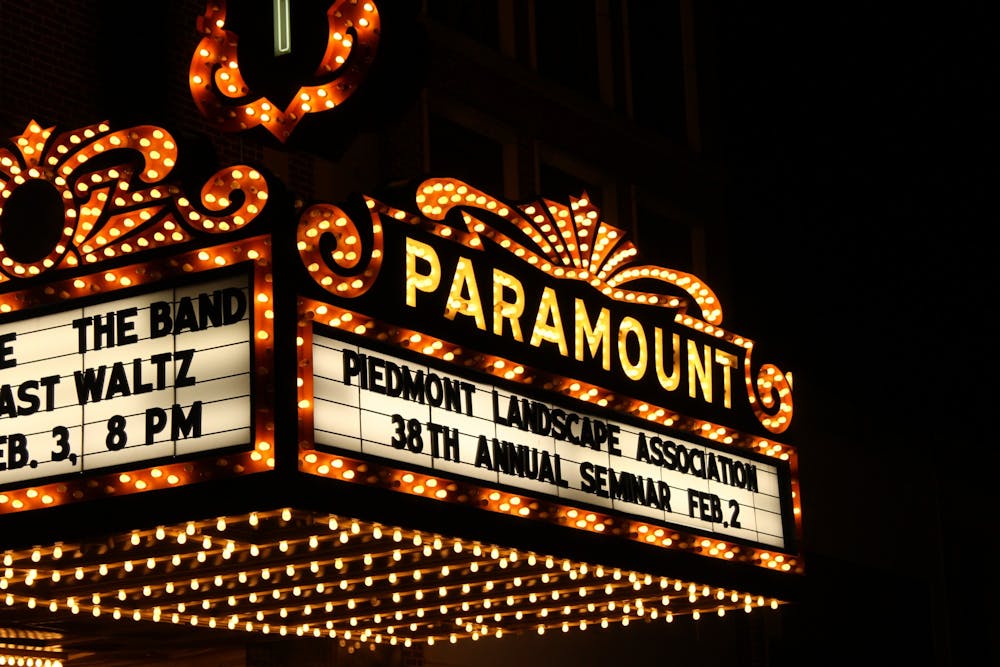For many, the experience of the Paramount Theater likely extends from the concession stand to the physical seats in the theater. Beyond the theater, though, there are many rooms rich in detail that complete this historic landmark.
Exclusive to staff and performers, at the corner of the stage is a stairwell that leads to the first floor of the theater referred to as an “artist wonderland” by Education and Outreach Manager Cathy von Storch. The backstage wall of fame is illuminated by bright yellow paint and includes thousands of signatures from artists who have performed at the theater since 2004. Among the signatures are award-winning artists Diana Ross and Tony Bennett, who performed at the grand reopening of the Paramount.
In a section of the backstage floor, a big green cartoon dinosaur winks up at viewers. As the story goes, when painters were working on the basement, the production team asked their boss what color he preferred for the floor. In a rush to head out of town, their boss replied that he wasn't interested — they could paint it dinosaur for all he cared. So once returning the boss was surprised to see a dinosaur painted on the floor thanks to his crew.
“[The dinosaur] is how we give directions down here, because it can get a little confusing where someone is at — someone would say, go to the [dinosaur] head and make a right,” Technical Manager Kyle Schneider said.
Along the hallway, the backstage has two large premier dressing rooms and two choral dressing rooms, each with a bathroom and shower for its guests. The layout of the first floor concludes with an original public lounge that includes a room that once served as a men's smoking lounge. While backstage is made for preparing for the show, the stage is the heart of performances and screenings.
Above the backstage floor lies the renowned two-story theater, which underwent renovations in the early 2000s. The center stage was expanded by 15 feet, creating ample space for performance.
The number of seats was reduced from over 1200 to 1041, and each seat was replaced with cozy soft velvet, providing maximum comfort and legroom. Furthermore, an interesting detail awaits the keen observer — not all seats are the same size, with a variation of three sizes.
“I always tell people to go in and find the right size for you and pick that seat because there really is a variety of seats,” Schneider said. “We host a gala every year and last year we actually took out another four rows of seats — in doing so we learned that the seats are not all the same as we were trying to put them back together.”
For live performances, the theater stage can accommodate a variety of events. The stage floor itself has springs and multiple layers of protection so that ballerinas can go en pointe easier and have extra support during dance performances. Beyond the stage, the Paramount features many rooms for socializing and hosting parties.
The grand staircase leads to the fourth floor with two large lounges, the Balcony Lounge and the Fonder's Lounge, both of which can be rented for events. Donors to the Paramount Theater are invited to the Founder's Lounge to enjoy the built-in bar and concession stand during intermission.
One magnificent design in the lounge, making it feel like a mystery movie, is a secret door that leads atop the Paramount marquee. Every floor of the theater — from the basement all the way to the fourth floor — proves to be enriched with history and details.
These days, the Paramount Theater is home to a multitude of events from live performances to The Virginia Film Festival. Thankfully to those involved in the renovation and reopening in 2004, the theater maintains its antique aesthetic with new inclusions to improve the audience experience, allowing it to stay alive and thrive.
“It was so important to those making the decisions about the restoration to hold onto the history [and] hold onto the architecture and its influences,” Storch said. “They were all a part of having this wonderful experience, escaping from the outside and entering a completely different place, spiritually and physically.”







